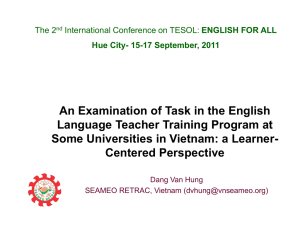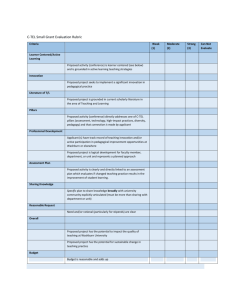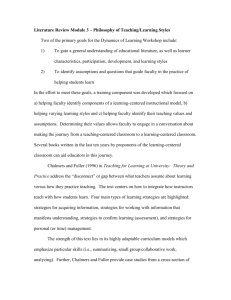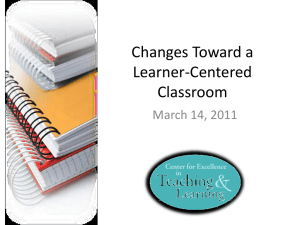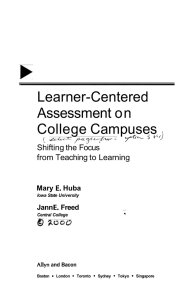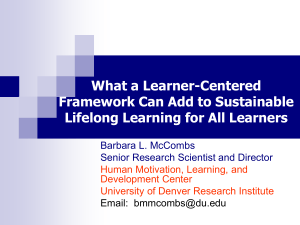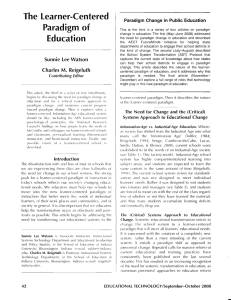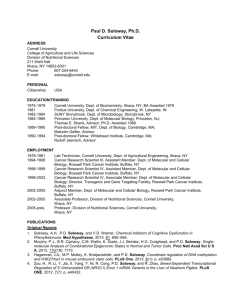Learner-Centered Design - Learning, Design and Technology
advertisement
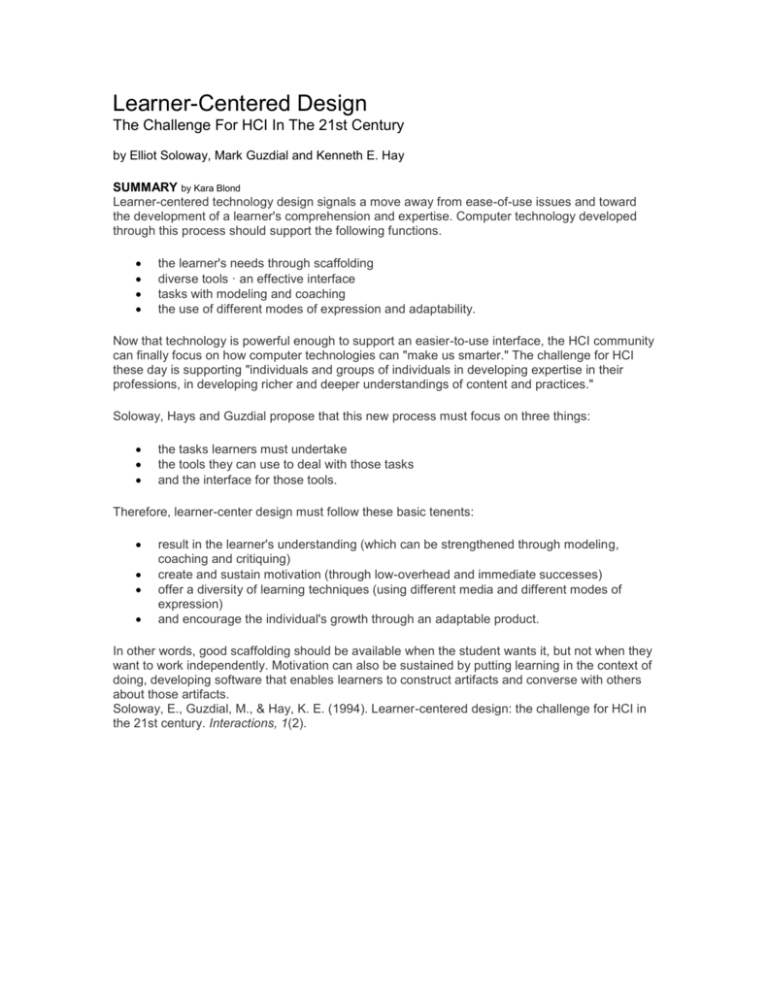
Learner-Centered Design The Challenge For HCI In The 21st Century by Elliot Soloway, Mark Guzdial and Kenneth E. Hay SUMMARY by Kara Blond Learner-centered technology design signals a move away from ease-of-use issues and toward the development of a learner's comprehension and expertise. Computer technology developed through this process should support the following functions. the learner's needs through scaffolding diverse tools · an effective interface tasks with modeling and coaching the use of different modes of expression and adaptability. Now that technology is powerful enough to support an easier-to-use interface, the HCI community can finally focus on how computer technologies can "make us smarter." The challenge for HCI these day is supporting "individuals and groups of individuals in developing expertise in their professions, in developing richer and deeper understandings of content and practices." Soloway, Hays and Guzdial propose that this new process must focus on three things: the tasks learners must undertake the tools they can use to deal with those tasks and the interface for those tools. Therefore, learner-center design must follow these basic tenents: result in the learner's understanding (which can be strengthened through modeling, coaching and critiquing) create and sustain motivation (through low-overhead and immediate successes) offer a diversity of learning techniques (using different media and different modes of expression) and encourage the individual's growth through an adaptable product. In other words, good scaffolding should be available when the student wants it, but not when they want to work independently. Motivation can also be sustained by putting learning in the context of doing, developing software that enables learners to construct artifacts and converse with others about those artifacts. Soloway, E., Guzdial, M., & Hay, K. E. (1994). Learner-centered design: the challenge for HCI in the 21st century. Interactions, 1(2). A Place Called Childhood by Allison Druin SUMMARY by Page McMullen The experience of being a child is changing due to the new multimedia computer environments with which children now interact. As a result, user interface designers must also change. It is not sufficient to try to remember what one liked as a child in attempt to design for children. Designers need to go to the source themselves for advice, children. Otherwise, designers are building interfaces on myths about kids and computers. Myth: Children love bright colors. Fact: Children want more than primary colors. Designers should incorporate meaningful graphics, readable fonts, and dynamic layouts. Myth: Loud sounds make applications fun. Fact: Designers need to ask "do sounds add meaning, ease, and entertainment to the application?" before incorporating sounds. Myth: "Children only care what's on the screen." Fact: Designers should look into a child's physical world and the future. How will children be interacting with computers in the next few years? Legos, stuffed animals, and other toys need to be part of the designer's toolset. Myth: "Children have no attention span." Fact: Children have an incredible capacity to focus on things of interest to them. Designers need to discover these activities of interests and exploit them for the learning potential they offer. Druin’s ultimate point is that including children in the design process ensures that these myths will not persist. Children’s ideas should be valued as an adult user’s would be, perhaps more so because of the honesty behind these ideas. Creative, engaging, and highly successful learning designs are developed when children are invited to be part of the design process. Druin, A (1996). A place called childhood. Interactions, 3(1), 17-22. Learner-Centered Education by Donald A. Norman and James C. Spohrer SUMMARY by Lia Woo "People learn best when engrossed in the topic, motivated to seek out new knowledge and skills because they need them in order to solve the problem at hand." In order for learner-centered education to fully engage the learner, technology applications must: Focus on the needs, skills, and interests of the learner. Incorporate a problem-based approach to learning, with the problem as the primary motivating force. Learner-centered education applications must be examined based on three dimensions: Engagement: Computer-based instruction offers the powerful capability to engage the learner by proving instant interaction and feedback. Effectiveness: Is the learner acquiring new knowledge? To determine effectiveness, new methods of evaluating technology and learner-centered pedagogy must be developed. Traditional measures of effectiveness will not suffice. Viability: Can a technology rich, learner-centered approach based on authentic problems realistically be implemented in schools? Viability proves the most difficult to address as it depends on social, cultural, and political issues. "Learners are just one of the stakeholders in the current education system. For the revolution to succeed, the needs of all stakeholders must be addressed… Learner-centered design addresses the need for learner engagement, but other stakeholders need designs that address the issues of effectiveness and viability." Norman, D. A., & Spohrer, J. C. (1996). Learner-centered education. Communications of the ACM, 39(4), 24-27. A Learner-Centered Tool for Students Building Models by Shari L. Jackson, Steven J. Stratford, Joseph Krajcik and Elliot Soloway SUMMARY by Nicole Reynolds LEARNING PROBLEM Students cannot easily create models that explain real-world phenomena. Computers allow modeling, but the way it's currently practiced, it's too difficult for pre-college students. SOLUTION Redefinition of the modeling task by applying learner-centered design. Focuses on scaffolding: providing support to learners while they engage in activities that are normally beyond their abilities. New program is called "Model-It". MODEL-IT SCAFFOLDING STRATEGIES: 1. Grounding Experience and Prior Knowledge: Model-It provides set of familiar high-level objects. - These objects are represented visually, ie: photographs and graphics. - Personalized representation helps to ground learning in a meaningful and authentic context. - Support of verbal representations rather than mathematical expressions allows students to create relationships based on representation through basic, English sentences. 2. Bridging Representations: New representations should be connected to learner's current understandings. - Model-It provides simultaneous, linked text-to-graphic representations. - This supports students in learning how to read and interpret graphs. 3. Coupling Actions, Effects and Understanding: Interactive learning environments should provide coupling between learner's actions, visual feedback and learner's mental representations. - Model-It allows students to directly manipulate factors and immediately see the impact. - Interactivity helps engage even students with low motivation. RESULTS: Open-ended tasks gave students flexibility to explore different topics. Students appropriately focused on high-level concepts. They were comfortable expressing themselves and ran additional simulations once they were able to conceive relationships. Jackson, S. L., Stratford, S. J., Krajcik, J., & Soloway, E. (1996). A learner-centered tool for students building models. Communications of the ACM, 39(4).

